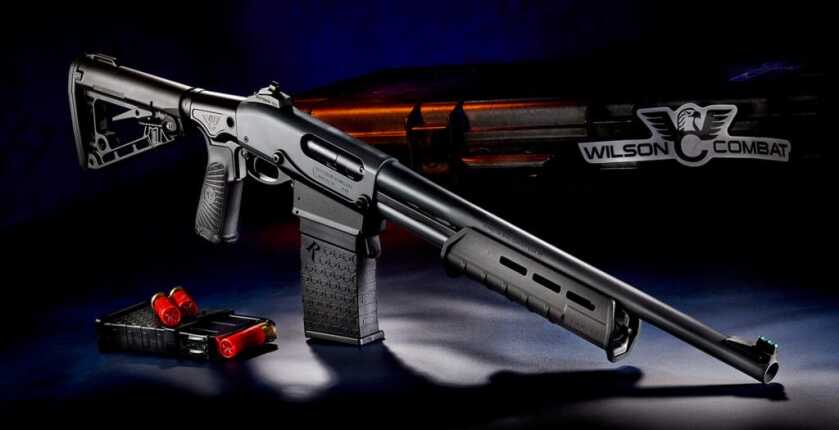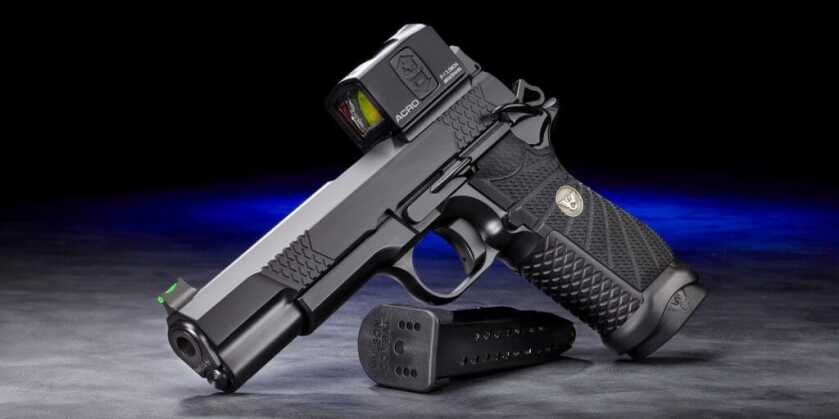
Wilson Combat has been a longtime friend to the Remington 870, taking care to produce new and refinished practical combat shotguns from even the oldest and most neglected bird guns. These reworked scatterguns come with a suite of improved features and the company’s latest is no exception.
Beginning with a magazine-fed 870, Wilson Combat is making three new styles of 12-gauge combat shotguns starting at $1,275. They have a base model with a conventional Hogue overmolded polymer stock, an enhanced version with a Magpul 870 stock, and a pistol grip option with an adjustable stock.
Regardless of stock choice, all three guns come with the same improved feature set including a rear ghost-ring sight, high-visibility fiber optic front sight, extended safety button and a Magpul forend.
The shotguns have 18.5-inch cylinder bore barrels with 3-inch magnum chambers. Standard magazines provide a 6+1-round capacity and of course, very fast reloads. All three come with Wilson Combat’s Armor-Tuff finish.
Unloaded the base model shotgun weighs just under 8 pounds, which means the other models will likely weigh a little more than that. Currently Wilson Combat only has the base model in stock although the other versions can’t be too far behind since they otherwise use standard components.
When they do become available the all-Magpul option will run $1,325 and the AR-compatible adjustable version $1,400.

See Also: Wilson Combat Custom Glock 43
In other Wilson news the custom specialist is rolling out new options for their recently-introduced EDC X9 double-stack 1911s chambered for 9mm Luger. Wilson Combat now offers enlarged, flared magwells, extended 18-round magazines and red dot optic mounts for the X9 series.
The magwell and True Zero red dot system require slide and frame modification by Wilson Combat and come with a refinishing job. And while the magwell is a proprietary modification exclusive to the EDC series, the True Zero mount is compatible with not just the X9, but all 1911 and Glock pistols as well.
The True Zero mounts stand out with integral rear sight mounts for co-witnessed iron sights and a wide range of compatible mini red dot sights.

I am not a big fan of a magazine fed Remington 870 but I know a lot of happy owners. They found it really useful to be able to load 6 rounds in a second.
You failed to mention the obvious; Remington is about half the price, depending on model.
I guess they got on the removable box magazine fed shotgun bandwagon. There are some shotgun platforms that removable magazines are needed. However the Remington 870 platform isn’t one of them. They should have just designed a whole new shotgun that is designed to take removable mags rather than tamper with what already exists and works well with a tube magazine.
This bastardization of a perfectly great shotgun is completely unnecessary. Adding an extended magazine tube is a much better way to go IMO. Why carry extra HUGE bulky magazines around and have to handle them to reload? Makes absolutely no sense, other than generating income for the after market manufacturer. With the tube magazine you have the capability to reload on the go without removing and replacing a huge hunk up plastic. Fire 2 shots, load 2 more shells. Fire 4, load 4. The ghost ring sight is a good addition, but the rest of the “tactical” stuff is mostly cosmetic. Anything to part you from your money!
A question came to mind as I viewed the photo of the optic mounted on the Wilson automatic at the end of this article. How much of a strain or impact does the mounting of the optic, on the rear of the slide of any automatic handgun, have on the optic itself or on the mounting itself?? The repetitive racking of the slide in normal operation of the handgun would seem to subject the mounted optic to very strong “G” forces and impact forces as the slide comes to a full stop in each direction, as the weapon is emptied of ammunition.
I can understand the short term effects of constant impacts on the mount and optic itself may be minimal, all things considered, but how would that impact rearward and forward, for each round of ammunition fired, affect the solidity and accuracy of the optic after, say, 1000 rounds or 5000 or 20000 rounds fired??